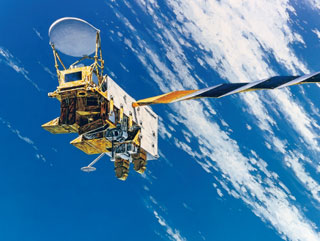Observation Halted
by Advanced Microwave Scanning Radiometer-EOS (AMSR-E)
Japan Aerospace Exploration Agency (JAXA)
The Japan Aerospace Exploration Agency (JAXA) has been operating the Advanced Microwave Scanning Radiometer-EOS (AMSR-E) for over nine years (despite a design life of three years) as an onboard device installed in the American earth observation satellite Aqua, after its launch on May 4, 2002. Since the end of August, 2011, however, the continuous increase of relatively large antenna rotation friction was detected twice, thus JAXA has been monitoring the condition. At 3:58 p.m. on October 4, 2011 (Japan Standard Time,) the AMSR-E reached its limit(*1) to maintain the rotation speed necessary for regular observations (40 rotations per minute), and the radiometer automatically halted its observations and rotation.
JAXA will continue to analyze this problem, and take necessary measures to correct the situation. We will also launch the successor to the AMSR-E, the Global Change Observation Mission 1st- Water "SHIZUKU" (GCOM-W1.)
*1) When rotation friction occurs, it is necessary to produce a turning force (torque) to offset the friction in order to maintain the rotation speed. The limit in this context means the maximum value of the torque (4.5 Nm,) which the AMSR-E's motor can produce.

Aqua/AMSR-E
|
|
(Reference) AMSR-E achievements
The AMSR-E is a microwave scanning radiometer with the world's highest performance. It can observe global-scale water, including ocean ice, surface temperatures, vapors, precipitation and soil water, regardless of weather conditions or if it is day or night by measuring faint radio waves emitted from the Earth.
(1) Contributing to practical areas
- The AMSR-E contributed to accuracy improvement of weather forecasts by meteorological agencies around the world such as the Japan Meteorological Agency as its data was used for numerical weather predictions and for determining the center of a typhoon.
- It was also helpful for more efficient operations of fishing boats as the data was used for compiling ocean condition information for fishing by a fishing industry information service center and other organizations.
- The radiometer also contributed to monitoring the Sea of Okhotsk by the Japan Coast Guard and editing a report on overseas food demands through studying global drought conditions by the Ministry of Agriculture, Forestry and Fisheries.
(2) Usefulness to water circulation and climate change fields
- Through long-time continuous observations of the Arctic ice, the AMSR-E was very helpful for understanding the impact of global warming by clarifying the smallest Arctic ice area in the observation history in the summer of 2007, and the second largest decrease of the area in the observation history in the summer of 2011.
- With data observed by other satellites, the radiometer's data greatly contributed to the global precipitation map.
- The data was also very useful for international climate change research.
For other AMSR-E achievements in the past, please also refer to the Space Activities Commission (SAC) report issued on Aug. 31, 2005.
SAC Report on Aug. 31, 2005 (Japanese language only)
http://www.jaxa.jp/press/2005/08/20050831_sac_amsr-e_j.html
<Reference links>
Earth Observation Center
http://www.eorc.jaxa.jp/en/index.php